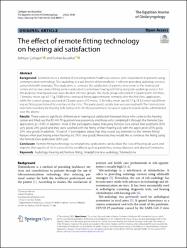| dc.contributor.author | Çelikgün, Bahtiyar | |
| dc.contributor.author | Büyükkal, Furkan | |
| dc.date.accessioned | 2023-06-02T05:51:20Z | |
| dc.date.available | 2023-06-02T05:51:20Z | |
| dc.date.issued | 2023 | en_US |
| dc.identifier.citation | Çelikgün, B. ve Büyükkal, F. (2023). The effect of remote fitting technology on hearing aid satisfaction. Egyptian Journal of Otolaryngology, 39(1). https://doi.org/10.1186/s43163-023-00447-7 | en_US |
| dc.identifier.issn | 1012-5574 | |
| dc.identifier.issn | 2090-8539 | |
| dc.identifier.uri | https://doi.org/10.1186/s43163-023-00447-7 | |
| dc.identifier.uri | https://hdl.handle.net/20.500.12511/11010 | |
| dc.description.abstract | Background: Telemedicine is a method of providing remote healthcare services and consultations to patients using communication technology. Tele-audiology is a sub-branch of telemedicine. It refers to providing audiology services using telehealth strategies. This study aims to compare the satisfaction of patients who come to the hearing aid center and receive device fitting service and patients who have hearing aid fitting using tele-audiology service. For this purpose, hearing aid users were divided into two groups. The study group consisted of 17 participants (10 male, 7 females; mean age 65.17 ± 13.88) who continued fitting appointments remotely after the first clinic application, while the control group consisted of 23 participants (10 males, 13 females; mean age 62.17 ± 18.32) who had all hearing aid fittings performed face-to-face in the clinic. The participant’s satisfaction was assessed with The International Outcome Inventory for Hearing Aids Turkiye (IOI-HA-TR) questionnaire because it is practical and can be administered over the phone. Results: There were no significant differences in hearing aid satisfaction between those who came to the hearing center and filled out the IOI-HA-TR questionnaire personally and those who completed it through the Remote Care application (p < 0.05). In addition, most of the participants stated that using Remote Care solved their problems (35% very good, 24% good) and they were satisfied with the fitting of their hearing aids with this application (35% good, 29% very good). In addition, 13 out of 17 participants stated that they would pay attention to the “remote fitting” feature when purchasing a new hearing aid (76% very good). Moreover, they would like to continue the fitting using the Remote Care application (65% yes). Conclusion: Remote fitting technology via smartphone applications can facilitate the lives of hearing aid users and improve their quality of life in cases of risky conditions such as pandemics, various diseases, and physical limitations. | en_US |
| dc.language.iso | eng | en_US |
| dc.publisher | Springer Medizin | en_US |
| dc.rights | info:eu-repo/semantics/openAccess | en_US |
| dc.subject | Audiology | en_US |
| dc.subject | Hearing Aid | en_US |
| dc.subject | Remote Fitting | en_US |
| dc.subject | Smartphone Tele-Audiology | en_US |
| dc.subject | Telemedicine | en_US |
| dc.title | The effect of remote fitting technology on hearing aid satisfaction | en_US |
| dc.type | article | en_US |
| dc.relation.ispartof | Egyptian Journal of Otolaryngology | en_US |
| dc.department | İstanbul Medipol Üniversitesi, Sağlık Bilimleri Fakültesi, Odyoloji Bölümü | en_US |
| dc.authorid | 0000-0001-9022-8209 | en_US |
| dc.identifier.volume | 39 | en_US |
| dc.identifier.issue | 1 | en_US |
| dc.relation.publicationcategory | Makale - Uluslararası Hakemli Dergi - Kurum Öğretim Elemanı | en_US |
| dc.identifier.doi | 10.1186/s43163-023-00447-7 | en_US |
| dc.institutionauthor | Büyükkal, Furkan | |
| dc.identifier.wos | 000989200100002 | en_US |
| dc.identifier.scopus | 2-s2.0-85159581735 | en_US |
| dc.identifier.scopusquality | Q4 | en_US |


















